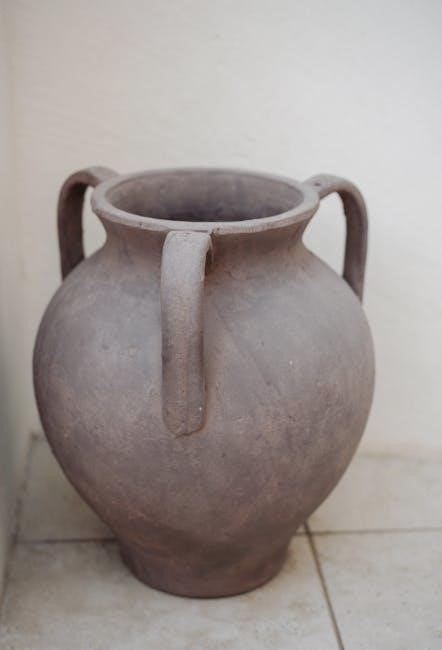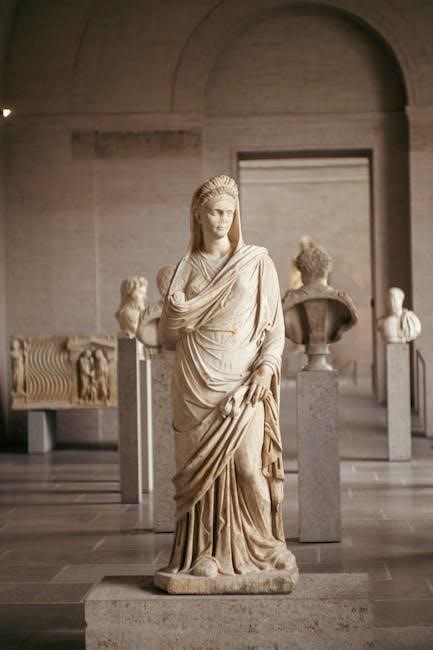John Keats’ Ode on a Grecian Urn is a timeless masterpiece exploring themes of beauty, truth, and the enduring power of art. Its intricate imagery and philosophical depth continue to captivate readers, making it one of the most celebrated poems in English literature.
1.1 Overview of the Poem
Ode on a Grecian Urn is a five-stanza ode written by John Keats in 1819 and published in 1820. The poem revolves around an ancient Greek urn, exploring its timeless beauty and the stories depicted on it. Keats personifies the urn, describing its scenes of love, sacrifice, and natural beauty. Through vivid imagery and philosophical reflection, the poem delves into themes of art, truth, and the transience of life. Its final lines, “Beauty is truth, truth beauty,” have become iconic in literary history.
1.2 Historical Context of the Poem
Written in May 1819, Ode on a Grecian Urn reflects John Keats’ fascination with classical Greek art and culture. During the Romantic era, there was a resurgence of interest in ancient Greek antiquities, which inspired Keats’ work. The poem was composed during a time of personal turmoil for Keats, including financial struggles and the early signs of tuberculosis, which later claimed his life at the age of 26; The urn’s imagery and themes of immortality resonated deeply with Keats’ own existential contemplations.
John Keats and His Odes
John Keats, a leading Romantic poet, is renowned for his odes, which explore themes of beauty, emotion, and the transience of life. His works include Ode to a Nightingale, Ode on Melancholy, and Ode on a Grecian Urn, showcasing his mastery of sensuality and imaginative depth.
2.1 Biography of John Keats
John Keats was born on October 31, 1795, in London, England. His early life was marked by hardship, including the loss of his father and struggles with financial instability. Despite these challenges, Keats pursued his passion for poetry, influenced by classical literature and the Romantic movement. His career as a poet was brief but impactful, producing masterpieces like Ode on a Grecian Urn and Ode to a Nightingale. Keats died tragically young at 26 from tuberculosis in 1821, leaving behind a legacy of profound beauty and emotional depth in his work.
2.2 Keats’ Other Notable Works
Besides the Ode on a Grecian Urn, Keats is renowned for his other odes, such as Ode to a Nightingale, Ode on Melancholy, and Ode to Psyche. His works also include Bright Star, La Belle Dame sans Merci, and To Autumn. These poems reflect Keats’ sensuality, love for beauty, and exploration of existential themes. His letters further reveal his philosophical insights, enriching his literary legacy and solidifying his place as a leading Romantic poet.
Structure and Style of the Poem
The poem is composed of five stanzas, each exploring different aspects of the urn’s imagery. Written in a Pindaric ode style, it features a lyrical, contemplative tone, blending rich imagery with philosophical reflection.
3.1 Stanza Breakdown
The poem is divided into five stanzas, each focusing on different scenes and themes depicted on the urn. The first stanza introduces the urn as a silent, eternal vessel of beauty. The second stanza contemplates the frozen moments of joy and suffering on the urn’s surface. The third stanza reflects on the transience of life, while the fourth stanza questions the identities of the figures and their stories. The final stanza delivers the famous conclusion, “Beauty is truth, truth beauty.”
3.2 Use of Imagery and Symbolism
Keats employs vivid imagery to bring the urn’s ancient scenes to life, creating a bridge between the viewer and the timeless art. The urn itself symbolizes enduring beauty and truth, while the depicted scenes of love, nature, and rituals evoke universal human experiences. Through metaphors like “silent, bridled joy” and “foster-child of silence,” Keats personifies the urn, transforming it into a narrator of eternal stories. This richness of imagery deepens the poem’s philosophical exploration of art and existence.

Themes in “Ode on a Grecian Urn”
The poem explores timeless themes such as beauty, truth, and the transience of life versus the timelessness of art, inviting readers to reflect on humanity’s enduring connection to art and nature.
4.1 Beauty and Truth
The poem delves into the interplay between beauty and truth, suggesting that they are inseparable. Keats posits that beauty is the ultimate truth, and truth is revealed through beauty. The urn, as an art object, embodies this duality, offering timeless insights into human experience. The final lines, “Beauty is truth, truth beauty,” encapsulate this profound philosophical idea, emphasizing art’s role in capturing enduring truths.
4.2 Transience of Life and Timelessness of Art
Keats contrasts life’s fleeting nature with art’s enduring quality. While human experiences are temporary, the urn’s depictions remain frozen in time, preserving moments of joy and sorrow. The poem highlights how art transcends mortality, offering an immortal glimpse into the past. This theme underscores the urn’s role as a vessel of permanence, bridging the gap between the transience of life and the timelessness of artistic expression, ensuring memories and emotions endure beyond human lifespans.

Analysis of Key Symbols
The urn and its depicted scenes symbolize the timeless essence of art, capturing life’s fleeting moments while transcending human mortality through enduring beauty and emotional resonance.
5.1 The Urn as a Symbol
The urn in Keats’ poem serves as a profound symbol of art’s timelessness and silence. It embodies the preservation of moments from Greek mythology, transcending mortality by capturing life’s essence. The urn’s imagery speaks to universal truths, bridging past and present through its immortalized scenes. As a “sylvan historian,” it silently narrates stories, reflecting the enduring power of beauty and the human experience.
5.2 Depiction of Scenes on the Urn

The urn’s surface is adorned with vivid, timeless scenes from Greek mythology and pastoral life. These include figures of deities, mortals, and imaginary creatures, set amidst landscapes like Tempe and Arcady. The imagery depicts joyous rituals, such as pipers playing and maidens dancing, alongside moments of longing and pursuit. Keats’ descriptions, like the “leaf-fring’d legend” and “p Piper’s life,” evoke a sense of wonder and melancholy, capturing life’s fleeting beauty and the eternal essence of art.
Critical Reception and Legacy
First published in 1820, the poem initially received mixed reviews but later gained acclaim for its profound exploration of beauty and truth, becoming a cornerstone of Romantic literature.
6.1 Contemporary Reviews
When first published in 1819 in Annals of the Fine Arts and later in 1820, the poem received mixed reviews. Some critics deemed its language overly sensual and its themes ambiguous, while others praised its depth and beauty. The poem’s exploration of timeless art and human emotion resonated deeply, despite initial skepticism. Its reputation grew steadily, solidifying its place as a masterpiece of Romantic literature.
6.2 Modern Interpretations and Scholarly Views
Scholars today emphasize the poem’s exploration of art’s timelessness and its reflection of human experience. The urn symbolizes enduring beauty, transcending mortality. Modern critics highlight Keats’ use of ekphrasis, blending visual and literary art. Interpretations often connect the poem to broader themes like the transience of life and the immortalizing power of art. Its philosophical depth and sensual imagery continue to inspire academic discourse, solidifying its status as a cornerstone of Romantic poetry and literary analysis.

Influence and Adaptations
Ode on a Grecian Urn has profoundly influenced literature and art, inspiring countless adaptations. Its themes of beauty and truth continue to resonate, making it a timeless classic.
7.1 The Poem’s Impact on Literature
Ode on a Grecian Urn has left an indelible mark on literature, inspiring poets and writers with its exploration of beauty, truth, and the immortality of art. Its influence can be seen in later Romantic and Victorian poetry, as well as in modern literary movements. The poem’s emphasis on sensory detail and philosophical reflection has made it a benchmark for lyrical poetry, shaping the way writers approach themes of timelessness and the human experience.

7.2 References in Popular Culture
Ode on a Grecian Urn has transcended literature, influencing various forms of popular culture. Its themes of beauty and timelessness are referenced in films, music, and visual arts. The poem’s imagery has inspired countless adaptations, from paintings to literary works, while its iconic lines, such as “Beauty is truth, truth beauty,” are frequently quoted in media and advertising, cementing its place in cultural consciousness.
John Keats’ Ode on a Grecian Urn masterfully explores themes of beauty, truth, and the timelessness of art. The urn, as a symbol, embodies the enduring power of artistic expression, leaving a profound and lasting impact on literature and culture.
8.1 Summary of Key Points

John Keats’ Ode on a Grecian Urn is a profound exploration of beauty, truth, and the timelessness of art. The poem, composed of five stanzas, personifies an ancient urn, using its imagery to convey eternal truths. It contrasts the transience of life with the immortality of art, emphasizing how moments frozen in time can transcend mortality. The urn’s scenes of divine and mortal life invite reflection on reality and perception, leaving a lasting impact on literature and culture.
8.2 Final Thoughts on the Poem’s Significance
Ode on a Grecian Urn stands as a masterpiece of Romantic literature, blending philosophical depth with exquisite beauty. Its exploration of timeless themes—beauty, truth, and the transience of life—continues to resonate universally. The poem’s ability to transcend time, connecting past and present, underscores its enduring relevance. Keats’ ode not only celebrates art’s immortality but also invites readers to reflect on existence, leaving an indelible mark on literary heritage and inspiring scholars and enthusiasts alike for generations.

Accessing the Poem

The poem is widely available in PDF format for free download, offering readers easy access to Keats’ timeless masterpiece. Many academic and literary websites provide the full text, often accompanied by analysis and historical context, making it a valuable resource for both students and enthusiasts of Romantic literature.
9.1 PDF Version of “Ode on a Grecian Urn”
The PDF version of Ode on a Grecian Urn is readily available online, offering a convenient way to read and study Keats’ iconic poem. Many websites provide free downloads of the poem in PDF format, often accompanied by detailed analysis, historical context, and scholarly insights. These resources are ideal for students and literature enthusiasts, allowing for easy access to the poem’s timeless beauty and profound themes. The PDF format ensures that the text is preserved in its original poetic structure and layout.
9.2 Recommended Readings and Resources
For deeper exploration, scholarly articles and analysis guides on Ode on a Grecian Urn are available online. Websites like Google Scholar and JSTOR offer access to critical essays and interpretations. Additionally, study guides from reputable sources provide insights into themes, imagery, and historical context. Platforms like Romantic Circles and academic databases feature comprehensive resources, including annotations and expert commentary. Libraries and online archives also offer free access to these materials, enriching your understanding of Keats’ masterpiece.
